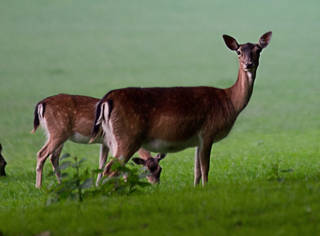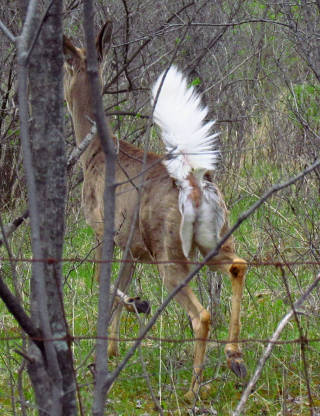A Pepper Grinder Post
Why do White-tailed Deer have White Tails?
I went for a walk the other day. It was a beautiful fall day. We live in a development but the houses aren’t too close together, especially on two spurs that go back away from the main road. We’re surrounded by trees and there is a fair amount of wildlife about. It was on one of those spurs where I saw foxes in the wild for the only time in my life. I was at about the same spot where I had seen the foxes, when I saw two White-tailed Deer.
 I grew up in upstate New York where, except during hunting season, there were lots of deer around, so seeing two deer wasn’t a stunning experience. On the other hand, I never get tired of watching those graceful creatures move. They weren’t too scared of me. They moved away from me at a quick walk at first, then started to run and leap a little when they reached the edge of the woods.
I grew up in upstate New York where, except during hunting season, there were lots of deer around, so seeing two deer wasn’t a stunning experience. On the other hand, I never get tired of watching those graceful creatures move. They weren’t too scared of me. They moved away from me at a quick walk at first, then started to run and leap a little when they reached the edge of the woods.
When I first saw the two does, they were facing me and they blended into the brown of the fallen leaves remarkably well. When they were moving away from me, it was a different story. If you ever wonder how White-tailed deer got their name, just look at one running away from you. When the deer are frightened, up go the tails, revealing the large white undersides of those tails. If it weren’t for those tails, I would have had trouble spotting the deer as they moved quickly away from me through the trees. With the tails though, it was like someone running away from you with a spotlight pointed in your direction on his back.
According to the theory of evolution, as deer evolved over time, there would have been various mutations. If mutations are happening frequently enough or over a long enough timespan to produce whole new species, it certainly seems reasonable to assume that there would have been deer without white tails. (Perhaps there are some species of deer now that don’t have white tails, though looking at a Wikipedia article just now, I was left with the impression that all deer had some white fur on their tails and rumps, even if it wasn’t as dramatic as White-tailed Deer.) In any case, according to evolutionary theory, the deer with the best survival rate would reproduce the most and would thus come to predominate.
 Which brings me to the title of this piece: why do White-tailed Deer have white tails? If I were a mountain lion chasing two deer, one of which had a light brown rear end that blended in with the forest floor, and the other of which had a bright white backside, guess which one I would chase? Since we predators would be gobbling up more of the white-tails than the other deer, most deer should NOT have white tails by now. And yet, the deer I have seen all my life have big bright white tails that are stunningly visible when running away from you.
Which brings me to the title of this piece: why do White-tailed Deer have white tails? If I were a mountain lion chasing two deer, one of which had a light brown rear end that blended in with the forest floor, and the other of which had a bright white backside, guess which one I would chase? Since we predators would be gobbling up more of the white-tails than the other deer, most deer should NOT have white tails by now. And yet, the deer I have seen all my life have big bright white tails that are stunningly visible when running away from you.
I am on perilous footing here. I am not a biologist and perhaps some evolutionary biologist could tell me some theory about why having those bright white tails gives a survival or reproductive advantage to the deer that have it.
And yet, my point isn’t just about those white tails. Look around at nature. Look at the mind-numbing variety, look at the colors, look at the complexity. It doesn’t look to me like something that happened by chance. (Try dumping a thousand blocks onto the floor a thousand times and see what the results look like.) It doesn’t even look like something that was designed by a utilitarian. It looks like something that was designed by someone who was the world’s best geneticist, biologist, and engineer, but who was also an artist. It looks like it was created by someone who, in the midst of all the practical considerations about how to make a deer, decided, on a fanciful notion, to give them bright white tails, and then laughed aloud at the idea. It looks like it was designed by someone who loved beauty and loved creating things.
This isn’t meant to be a scientific argument. If you want that, there are some excellent books about Intelligent Design. One of my favorites is Darwin’s Black Box by Michael Behe. This is just me musing and wondering, “Why do White-tailed deer have white tails?”
- Pepper
Posted 2013-11-14
Comments on this post:
Well, you certainly succeeded at not making a scientific argument!
-Rex November 17, 2019
Hi Rex,
I'm a little confused. I gather you're annoyed that I commented on a scientific theory without using 'scientific' arguments. However, I said openly that I wasn't trying to make a scientific argument, and I referred you to an excellent book you could read if you wanted a scientific argument from a similar perspective to mine. (Another fantastic book I read recently, also by Michael Behe, is called 'Darwin Devolves.' It looks at some of the latest research on DNA and the problems this presents for evolution.)
Is the problem that no one but scientists are allowed to give their opinion on scientific theories? It's not that I expect the entire scientific community to be stunned by my 'incredibly astute' observations about white-tailed deer, but I do wonder what's wrong with me sharing my opinion.
Another huge problem I have is the idea that only scientists can be believed and trusted in matters of science. One of my problems with this is the question of who is a scientist. To me, it seems that to be considered a scientist in our day and age, one MUST start with the premise that nothing outside of the physical world we perceive with our senses is real. Well, really, you can believe things that no one has or probably ever will perceive, but they have to be things that don't sound spiritual or religious. So, for example, Francis Crick (one of the co-discoverers of the structure of DNA) can postulate that DNA had been planted on earth by aliens, and still be considered a brilliant scientist. Respected scientists can get around the infinitessimally small chances of life as we know it evolving by chance by proposing the idea of an almost infinite number of parallel universes and saying that we just happened to have hit the jackpot and landed in the right one. But, if a scientist should espouse the theory that God had some part in bringing about life on earth, he has crossed the line and is no longer a real scientist.
You may say, 'But we can test scientific theories. We can't test a belief in God.'
I say: 'Has the theory of evolution been proven?'
You'll say, 'Of course! It's been proven by the fossil evidence.'
But has it?
Guess who was instrumental in changing the reigning theory of evolution from gradual Darwinian evolution to Punctuated Equilibrium? It was the paleontologists. They were simply not finding evidence of the transitional species that Darwin's theory had predicted. So the theory accepted by most evolutionists now holds that there were long periods of stasis followed by short bursts of frenetic activity when new life forms evolved in a period of time too short to show up in the fossil record. In other words, the evidence failed to support Darwin's theory, so the theory was just switched to something that could neither be proven or disproven. Meanwhile, high school biology teachers continue to present Darwin's original theory as though it is a proven fact. Any attempts even to have Intelligent Design mentioned as an alternative theory are met with the kind of hysteria we would expect if someone wanted to start teaching the kids eugenics (which was also a widely-held scientific belief not that long ago).
What all this means is that science is no longer scientific--it is a religion. Sure, a scientist *can* have some religious beliefs, but only if he never lets those beliefs encroach on how he sees the world that science deals with.
Here is what I believe: God is real. More real, in fact, than the physical world that surrounds us. I don't think there is some dividing line that separates the realm of science from the spiritual realm. It's all God's world.
-Pepper November 23, 2019
